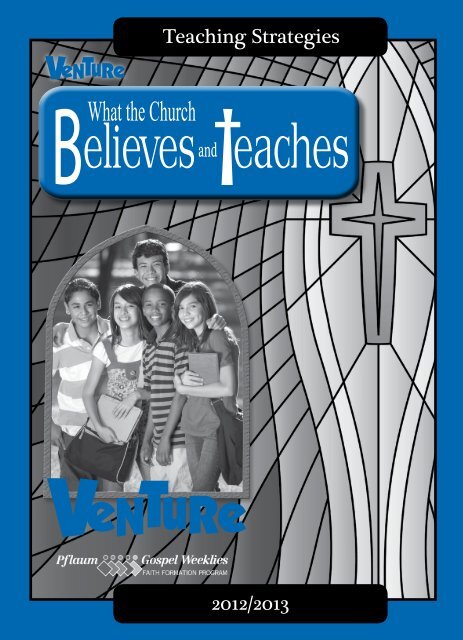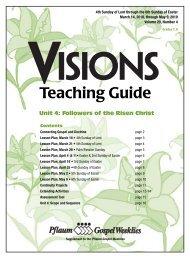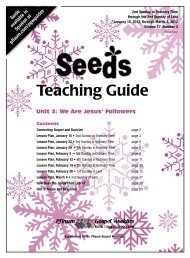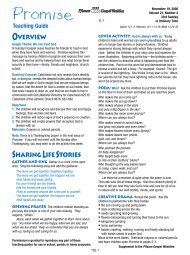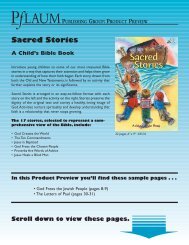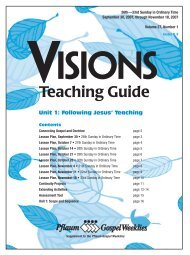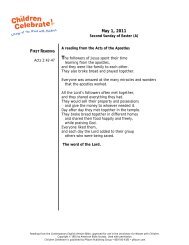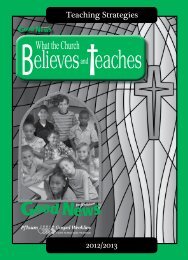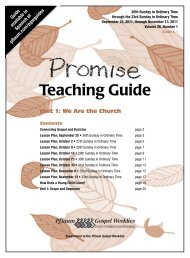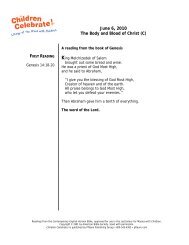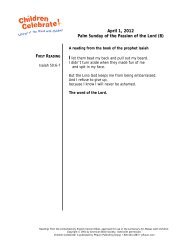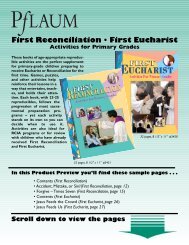Venture - Pflaum Gospel Weeklies
Venture - Pflaum Gospel Weeklies
Venture - Pflaum Gospel Weeklies
You also want an ePaper? Increase the reach of your titles
YUMPU automatically turns print PDFs into web optimized ePapers that Google loves.
Teaching Strategies<br />
What the Church<br />
elieves eaches<br />
and<br />
2012/2013
Writer: Sr. Alice Ann Pfeifer, CSA<br />
Editor: Karen Cannizzo<br />
Cover and interior design: Kathryn Cole and Ellen Wright<br />
The Subcommittee on the Catechism, United States Conference of Catholic Bishops, has found the doctrinal<br />
content of this manual, copyright 2010, 2011, 2012 to be in conformity with the Catechism of the Catholic Church.<br />
Nihil Obstat: Reverend Thomas L. Knoebel, Ph.D., Censor Librorum, June 29, 2009<br />
Imprimatur: † Most Reverend William Patrick Callahan, Bishop of Milwaukee, July 13, 2009<br />
Where appropriate, this text reflects the language of the Roman Missal, Third Edition.<br />
Scripture quotations contained herein are from the New Revised Standard Version Bible: Catholic Edition, copyright<br />
© 1993 and 1989 by the National Council of the Churches of Christ in the United States of America. Used by<br />
permission. All rights reserved.<br />
© 2010, 2011, 2012 <strong>Pflaum</strong> Publishing Group. All rights reserved. No portion of this text may be reproduced in any<br />
way or for any use without written permission of the publisher.<br />
<strong>Pflaum</strong> Publishing Group<br />
2621 Dryden Road, Suite 300<br />
Dayton, OH 45439<br />
800-543-4383<br />
pflaum.com
What the Church<br />
Believes and Teaches<br />
Teaching Strategies<br />
2012-2013<br />
Introduction to What the Church Believes and Teaches................................................................................................5<br />
Tips for Teaching Pre-Teens.............................................................................................................................................5<br />
TEACHING STRATEGIES<br />
Believe<br />
1. People Want to Be Close to God................................................................................................................................6<br />
2. God Wants to be Close to People...............................................................................................................................6<br />
3. Jesus Spoke to All Generations..................................................................................................................................6<br />
4. What Is Faith?..............................................................................................................................................................6<br />
5. How Can God Be Both One and Three?....................................................................................................................7<br />
6. How Did the World Begin? .........................................................................................................................................7<br />
7. What Are Angels?.........................................................................................................................................................7<br />
8. Who Were the First Human Beings?..........................................................................................................................7<br />
9. How Is Jesus the Savior?.............................................................................................................................................7<br />
10. What Is the Mystery of the Incarnation?...................................................................................................................7<br />
11. What Is the Mystery of the Immaculate Conception?..............................................................................................8<br />
12. What Was the Mission of Jesus?.................................................................................................................................8<br />
13. What Is the Church?....................................................................................................................................................8<br />
14. What Is the Mission of the Church?...........................................................................................................................8<br />
15.What Are the Marks of the Church?...........................................................................................................................9<br />
16.What Do Catholics Believe about Death and Resurrection?....................................................................................9<br />
Quick Quiz.........................................................................................................................................................................9<br />
Praise and Celebrate<br />
1. What Is the Liturgy?....................................................................................................................................................9<br />
2. What Is the Liturgical Calendar?................................................................................................................................9<br />
3. What Are the Sacraments of Initiation?.....................................................................................................................9<br />
4. What Happens at Baptism?........................................................................................................................................9<br />
5. What Happens at Confirmation?.............................................................................................................................10<br />
6. What Happens at the Eucharist?..............................................................................................................................10<br />
7. What Are the Sacraments of Healing?.....................................................................................................................10<br />
8. What Happens in the Sacrament of Penance and Reconciliation?.......................................................................10<br />
9. What Happens in the Anointing of the Sick?..........................................................................................................10<br />
10. What Are Sacraments at the Service of Communion?...........................................................................................10<br />
11. What Happens in the Sacrament of Holy Orders?..................................................................................................10<br />
12. What Happens in the Sacrament of Matrimony?...................................................................................................11<br />
Quick Quiz.......................................................................................................................................................................11
Follow Jesus<br />
1. What Is the Moral Law?............................................................................................................................................11<br />
2. What Makes a Well-Formed Conscience?...............................................................................................................11<br />
3. What Is Virtue?..........................................................................................................................................................12<br />
4. What Is Sin?...............................................................................................................................................................12<br />
5. Why Is Working for the Common Good Important?..............................................................................................12<br />
6. How Are God’s Law and God’s Grace Connected?..................................................................................................12<br />
7. The Ten Commandments Are for Everyone...........................................................................................................12<br />
8. What Does the New Law Ask of Us?.........................................................................................................................13<br />
9. What Are the Precepts of the Church?.....................................................................................................................13<br />
10. Why Are Church Leaders Important?......................................................................................................................13<br />
Quick Quiz.......................................................................................................................................................................14<br />
Pray<br />
1. There Are Six Kinds of Prayer...................................................................................................................................14<br />
2. The Holy Spirit Is Our Teacher.................................................................................................................................14<br />
3. There Are Three Ways to Pray...................................................................................................................................14<br />
4. Prayer Changes People.............................................................................................................................................14<br />
5. God Listens and Responds.......................................................................................................................................14<br />
6. Jesus Taught Us How to Pray....................................................................................................................................14<br />
Quick Quiz.......................................................................................................................................................................15<br />
Treasures of the Catholic Faith<br />
Faith Facts to Remember...............................................................................................................................................15<br />
Prayers to Know..............................................................................................................................................................15<br />
Words to Know................................................................................................................................................................15
Welcome to the<br />
<strong>Pflaum</strong> <strong>Gospel</strong> <strong>Weeklies</strong><br />
Faith Formation Program:<br />
What the Church Believes and Teaches<br />
The sacred duty and the joy of each succeeding<br />
generation of Christian believers has been<br />
to hand on the deposit of faith that was first<br />
entrusted to the apostles by Christ himself. We<br />
have received this gift, the deposit of faith—we<br />
have not conceived it. It is the heritage of the<br />
whole Church. It is our privilege and our responsibility<br />
to preserve the memory of Christ’s words<br />
and the words themselves and to teach future<br />
generations of believers to carry out all that Christ<br />
commanded his apostles.<br />
National Directory for Catechesis, #26<br />
For over a quarter century, the <strong>Pflaum</strong> <strong>Gospel</strong> <strong>Weeklies</strong><br />
have provided schools and parish religion programs<br />
with a basic catechesis on the Sunday <strong>Gospel</strong>s. These<br />
widely acclaimed magazines offer the finest in upto-the-minute<br />
catechetical reflections, exercises, and<br />
activities based on the words of Jesus Christ and on his<br />
<strong>Gospel</strong> as celebrated weekly in the Sunday assembly.<br />
The <strong>Weeklies</strong> have formed several generations of young<br />
people and helped bring faith to their lives and bring<br />
their lives to the Catholic faith.<br />
The basic teachings of the Catholic faith are seeded<br />
generously throughout each level of the <strong>Weeklies</strong>. These<br />
basic teachings are documented in an annual Scope and<br />
Sequence. Nonetheless, because of the very nature of a<br />
lectionary-based resource, the basic teachings do not<br />
occur in exactly the same way each year in the 32 issues<br />
of each level of the <strong>Weeklies</strong>.<br />
Therefore, <strong>Pflaum</strong> Publishing Group has undertaken to<br />
make part of each year’s subscription to the <strong>Weeklies</strong> a<br />
student’s handbook of those elements of the Catechism<br />
of the Catholic Church that have been judged necessary<br />
and appropriate for the age group served by each level.<br />
What the Church Believes and Teaches is a new component<br />
for the <strong>Pflaum</strong> <strong>Gospel</strong> <strong>Weeklies</strong>. At the beginning<br />
of each year—with the first shipment of the <strong>Weeklies</strong>—<br />
every child will receive his or her own book of basic<br />
Church teachings. The content for this book is based<br />
on protocols established for the teachings to be learned<br />
and mastered at each level of elementary-age catechesis.<br />
This handbook gathers under one cover the Church<br />
teachings presented in the 32 issues of the <strong>Pflaum</strong> <strong>Gospel</strong><br />
<strong>Weeklies</strong>. Teaching Stratgies provide you with ways<br />
to help children master these teachings. In addition, the<br />
guide that accompanies each issue of the <strong>Weeklies</strong> will<br />
point you to the handbook and to those teachings that<br />
are reflected in that issue. What the Church Believes and<br />
Teaches, together with the <strong>Weeklies</strong>, can also be of great<br />
help to parents who want to take an active role in the<br />
faith formation of their children.<br />
The handbook provides, in one convenient publication,<br />
all the teachings that must be mastered. The weekly<br />
issues provide the stories, exercises, activities, reflections,<br />
prayers, and challenges that show how a faithful<br />
Catholic can live out these teachings, celebrate them in<br />
the liturgy, and share them at home, at school, and with<br />
friends.<br />
Learning by Heart<br />
Much of what you find in What the Church Believes and<br />
Teaches can be learned by heart. From earliest times,<br />
catechesis has used the formulations of the Creed, the<br />
sacraments, the Commandments, and prayers (especially<br />
the Lord’s Prayer) to transmit the faith. The handbook<br />
affords you the opportunity to help your students<br />
learn by heart the principal expressions of the faith,<br />
basic prayers, key biblical themes, personalities, and<br />
language. Such learning is not mere rote. Memorization<br />
is an effective form of catechesis that nourishes the<br />
human heart and helps form the human spirit in Christ.<br />
Conclusion<br />
It is our hope that this new and exciting addition to<br />
the wondrous experience of the <strong>Pflaum</strong> <strong>Gospel</strong> <strong>Weeklies</strong><br />
will assist you in your ministry. It is our prayer that<br />
What the Church Believes and Teaches will give you the<br />
added assurance that you are indeed cultivating in your<br />
students the good soil in which the seed of the Catholic<br />
faith can take root and bring forth a lifetime of good<br />
fruit.<br />
Tips for Teaching Pre-Teens<br />
Pre-teens are a little like sophomores in high school—<br />
neither fish nor fowl. They are no longer the youngest<br />
kids in school and not yet the oldest kids in school.<br />
However, in their own minds, many already are making<br />
big plans for their teen years. By the time a boy reaches<br />
the age of 10, for example, he knows what kind of car he<br />
wants when he gets his license.<br />
Pre-teens’ bodies do lag behind the fantasies of their<br />
minds, though. It is common for young people in this<br />
age group to experience actual, physical growing pains.<br />
If forced to sit too long in one position, they can get<br />
muscle pains and cramps. That’s why it is important for<br />
you to build changes of posture into your class routines.<br />
Have students stand, for example, whenever you sing or<br />
pray together. You can also make physical activity part<br />
5
of some question-and-answer games. The results of<br />
brainstorming in discussion groups can be shared in a<br />
relay race. Two teams can line up with the person at the<br />
front of each line racing to the chalkboard or newsprint<br />
to record an idea on a given topic. That student returns<br />
to his or her team and hands off the chalk or marker to<br />
the next person, who races forward to record another<br />
idea the group has brainstormed. The first team to send<br />
every member forward with a new idea to record wins<br />
the relay.<br />
Growing pains can be mental as well as physical. Be<br />
aware of the children’s self-consciousness about their<br />
appearance and their changing bodies. During casual<br />
moments, such as when the students are entering or<br />
leaving the classroom, give individuals positive feedback<br />
about attractive new outfits, haircuts, glasses, and<br />
so on. Never call attention to any physical trait that<br />
might cause a child anxiety, such as shortness in a boy<br />
or chubbiness in a girl. Be vigilant about correcting any<br />
student who teases or mocks another student’s person<br />
or appearance.<br />
Psychologically, pre-teens need to feel a sense of<br />
belonging to any group they are part of. If you notice<br />
that one student is something of an outsider, there are<br />
little things you can do to advance the student’s status<br />
within the group. Discover the student’s talents and give<br />
him or her a chance to shine by using those talents in<br />
a group activity. Make it a point to invite the student’s<br />
opinions during class discussions and, without making<br />
the student a teacher’s pet, affirm anything special<br />
you notice about the student. Take time outside of class<br />
to talk with the person and to get to know him or her<br />
a little better. Religious educator Henrietta Mears has<br />
observed that “many a child has learned first to love his<br />
teacher, and then his teacher’s God.”<br />
Believe<br />
1. People Want to Be Close to God, page 6<br />
(1) Have students brainstorm a list of things in nature<br />
that show the beauty that God has created. (2) Then<br />
let them make a class mural that incorporates all the<br />
images. They can do this either with crayon on newsprint<br />
or with chalk on the chalkboard.<br />
(1) Ask students to keep completely quiet for three minutes<br />
after you read aloud Psalm 23. During that time,<br />
they are to listen to God speak to them in their hearts.<br />
Here, for example, is how God might speak today to<br />
express the thought of the psalm’s first line: “Dear one,<br />
know that I will always take care of you, the same way a<br />
good farmer cares for his animals—or the way a loving<br />
family cares for their pets.” (2) After the three minutes<br />
are up, ask students to write on a picture postcard or<br />
a blank greeting card what God said to them through<br />
Psalm 23. (3) Collect the cards and re-distribute them,<br />
so that each student gets someone else’s reflection to<br />
keep as a Bible bookmark.<br />
2. God Wants to Be Close to People, page 6<br />
(1) Have each student make a chain of five paper<br />
dolls, then decorate each “person” to look like one of<br />
these biblical figures involved in a covenant with God:<br />
Adam, Noah, Abraham, Moses, Jesus. Before students<br />
begin decorating, brainstorm ways to distinguish each<br />
character: Adam holding an apple, Noah with a white<br />
beard and holding a dove, and so on. (2) When students<br />
are finished, ask a volunteer to stand up with his or her<br />
finished artwork and explain what God promised to<br />
each person. (3) Then ask the class what each person<br />
promised God in return. (4) Remind students that a covenant<br />
is always an exchange of promises between two<br />
parties—a little like the wedding vows that a bride and<br />
groom exchange.<br />
(1) Obtain a copy of the baptismal promises. (2) Conduct<br />
a prayer service in which the students renew their<br />
baptismal promises. Begin with a suitable hymn, and<br />
end by sprinkling the class with holy water as they make<br />
the Sign of the Cross.<br />
3. Jesus Spoke to All Generations, page 7<br />
(1) Draw on poster board a large treasure chest with<br />
its lid open. Tell students it represents the Church’s<br />
Deposit of Faith. In it are found pearls of Scripture and<br />
diamonds of Tradition. At this point, you may wish to<br />
remind students of the definitions of Scripture and<br />
Tradition in their books. Sacred Scripture is the books<br />
of the Old and New Testament. Tradition is God’s Word<br />
given through the Church’s doctrine, life, and worship.<br />
(2) Brainstorm with the class for examples of Scripture<br />
and Tradition. Each time an example is named, paste a<br />
paper pearl (a round white circle) or a paper diamond (a<br />
yellow diamond shape) inside the chest.<br />
You can do this same activity using a real chest or jewelry<br />
box, and using dull-colored pebbles to represent<br />
pearls and shiny rocks to represent diamonds.<br />
4. What Is Faith? page 8<br />
(1) Distribute paper and pencils. Have students privately<br />
brainstorm lists of “little acts of faith” and “big acts of<br />
faith” that they themselves can do. In the first category<br />
they are to name things like “Pray an Our Father” and<br />
“Share a candy bar.” In the second category they are to<br />
name things like “Pray a Rosary” and “Give $20 to the<br />
poor.” (2) When students are finished, have them pair<br />
up and make one single list of “little acts” and one single<br />
list of “big acts” by putting their two lists together. (3)<br />
Find out which pair has the longest list of “little acts”<br />
6
and have them share their list with the class. (4) Do the<br />
same for the pair with the longest list of “big acts.”<br />
5. How Can God Be Both One and Three? page 8<br />
(1) Ask students for their ideas on why God the Father<br />
often is pictured as a hand reaching down from heaven<br />
or as an all-seeing eye. (These symbols show God as allpowerful<br />
and all-knowing.) (2) Ask for reasons why God<br />
the Son often is pictured as a lamb or as a shepherd.<br />
(John the Baptist called Jesus “the Lamb of God who takes<br />
away the sin of the world” (John 1:29). In John 10:11,<br />
Jesus said, “I am the good shepherd. The good shepherd<br />
lays down his life for the sheep.”) (3) Ask why the Holy<br />
Spirit often is pictured as a dove or a flame. (At Jesus’<br />
baptism, the Holy Spirit came in form of a dove. Fire is a<br />
symbol of the energy of the Holy Spirit.)<br />
6. How Did the World Begin? page 8<br />
(1) Tell students the story of Joseph by summarizing<br />
Genesis 37-47 from an adult Bible or by reading them his<br />
story from a children’s Bible. (2) Discuss Joseph’s story<br />
as an example of God bringing something good out of<br />
something bad. (3) Share any personal stories you may<br />
have of something good coming out of something bad.<br />
(1) Go online at http://www.chinapage.com/story/<br />
losthorse.html for the old Chinese story called “Blessing<br />
or Bane.” (2) Read the story to students and discuss it<br />
as an example of God bringing something good out of<br />
something bad for this Chinese family.<br />
7. What Are Angels? page 9<br />
(1) Ask students for examples of times when they had<br />
close calls but were protected from physical harm.<br />
(2) Ask students for examples of times when they did<br />
the right thing even when it was hard to do the right<br />
thing. (3) Point out that both times their Guardian<br />
Angels were protecting them and guiding them.<br />
(1) Mention that some children like to name their<br />
Guardian Angels—or to ask their angels for their name<br />
and listen to the answer they get in their hearts. (2) Suggest<br />
that students write thank-you letters to their Guardian<br />
Angels for all the times they received guidance and<br />
protection from them. They should begin their letters<br />
by addressing their angel by name. (3) Have students<br />
decorate their letters with drawings showing what they<br />
imagine their Guardian Angels might look like. (4) When<br />
students are finished, ask for two or three volunteers to<br />
share their letters and drawings with the class.<br />
8. Who Were the First Human Beings? page 9<br />
To help students understand the consequences of Adam<br />
and Eve’s disobedience to God, ask them what consequences<br />
they face when they disobey their own parents.<br />
What do they lose?<br />
9. How Is Jesus the Savior? page 10<br />
(1) Many Catholic parishes have names associated<br />
with titles for Christ and mysteries in the life of Christ.<br />
How many such parishes can students name? Their list<br />
will include names such as Good Shepherd, Christ the<br />
King, Sacred Heart, Divine Savior, Transfiguration, and<br />
so on. (2) Make sure students understand the meaning<br />
of each parish name. Provide the information yourself,<br />
or assign a different name to each student to research<br />
online. Then have students give oral reports on what<br />
they learned.<br />
10. What Is the Mystery of the Incarnation? page 10<br />
(1) Before the class meets, copy the passages from Mark<br />
given below on separate slips of paper and put them in<br />
a hat. (2) Discuss with the class which parts of Scripture<br />
show Jesus in his humanity: times he ate, drank, slept,<br />
experienced human emotions. Do the same with parts<br />
of Scripture that show Jesus in his divinity: times he forgave<br />
sins, worked miracles, prophesied. (3) Divide the<br />
class into two or three teams with the same number of<br />
players in each team, and have the teams stand together<br />
against one wall of the classroom. (4) Team members<br />
take turns drawing slips of paper from a hat and reading<br />
aloud the <strong>Gospel</strong> passages written on them. (5) Each<br />
reader is to identify whether the passage says something<br />
about Jesus as God or Jesus as man. If correct, he or she<br />
crosses the room to the opposite wall. (6) The first team<br />
to get all its members across the room wins the game.<br />
Passages Showing Jesus’ Humanity<br />
In the morning, while it was still very dark, he got up ….<br />
(1:35)<br />
When the scribes of the Pharisees saw that he was eating<br />
with sinners…. (2:16)<br />
He looked around at them with anger; he was grieved at<br />
their hardness of heart…. (3:5)<br />
He told his disciples to have a boat ready for him because<br />
of the crowd, so that they would not crush him. (3:9)<br />
He was in the stern, asleep on the cushion…. (4:38)<br />
He was amazed at their unbelief. (6:6)<br />
But when Jesus saw this, he was indignant and said to<br />
them, “Let the children come to me….” (10:14)<br />
On the following day, when they came from Bethany, he<br />
was hungry. (11:12)<br />
And he said to them, “I am deeply grieved, even to death;<br />
remain here, and keep awake.” (14:34)<br />
Then Jesus gave a loud cry and breathed his last. (15:37)<br />
7
Passages Showing Jesus’ Divinity<br />
And a voice came from heaven, “You are my Son, the<br />
Beloved; with you I am well pleased.” (1:11)<br />
And he cured many who were sick with various diseases,<br />
and cast out many demons…. (1:34)<br />
When Jesus saw their faith, he said to the paralytic, “Son,<br />
your sins are forgiven.” (2:5)<br />
He said to her, “Daughter, your faith has made you well;<br />
go in peace and be healed of your disease.” (5:34)<br />
He called the twelve and began to send them out two by<br />
two, and gave them authority over the unclean spirits.<br />
(6:7)<br />
He came towards them early in the morning, walking on<br />
the sea. (6:48)<br />
Jesus said to him, “Go, your faith has made you well.”<br />
Immediately he regained his sight…. (10:52)<br />
And when they had taken their places and were eating,<br />
Jesus said, “Truly I tell you, one of you will betray me, one<br />
who is eating with me.” (14:18)<br />
He said to them, “This is my blood of the covenant, which<br />
is poured out for many.” (14:24)<br />
Jesus said to him, “Truly I tell you, this day, this very<br />
night, before the cock crows twice, you will deny me three<br />
times.” (14:30)<br />
Now after he rose early on the first day of the week, he<br />
appeared first to Mary Magdalene, from whom he had<br />
cast out seven demons. (16:9)<br />
So then the Lord Jesus, after he spoke to them, was taken<br />
up into heaven and sat down at the right hand of God.<br />
(16:19)<br />
11. What Is the Mystery of the Immaculate<br />
Conception? page 10<br />
(1) Tell students the story of St. Bernadette, the young<br />
girl who saw Mary and heard her say that she was the<br />
Immaculate Conception. You can find Bernadette’s<br />
story online by clicking on “Saint of the Day” at<br />
americancatholic.org/features/saints/saint.aspx?id<br />
=1355 (2) Make sure students understand that Mary’s<br />
Immaculate Conception is important because it underscores<br />
the holiness of Mary. In choosing her to be the<br />
mother of his son, God blessed Mary more than any<br />
other human person.<br />
12. What Was the Mission of Jesus? page 11<br />
(1) Write on eight different pieces of yellow paper and<br />
eight different pieces of blue paper the following parts<br />
of John 3:16—God loved / the people of this world / so<br />
much that he / gave his only son, / so that everyone /<br />
who has faith in him / will have eternal life / and never<br />
really die. (2) Before students assemble for class, hide<br />
the sixteen pieces of paper all over the room. (3) When<br />
students arrive, form a blue team and a yellow team.<br />
Tell students their task is to search the room for pieces<br />
of paper in their team color, then return to their team<br />
“base” to put the pieces together in the proper order.<br />
Their correctly assembled sentence will answer the<br />
question, “What was the mission of Jesus?” The team<br />
that is first to finish wins the game.<br />
13. What Is the Church? page 11<br />
(1) Read to students 1 Corinthians 12:12-13. (2) On a<br />
large piece of newsprint, have a student lie down and let<br />
another student whom he or she chooses use a crayon<br />
to trace his or her outline on the paper. (3) Have students<br />
fill the outline with pictures of all different kinds<br />
of people cut out from magazines. Students should<br />
look for contrasts in the pictures they choose—old and<br />
young, dark and light, thin and fat, and so on. (4) Students<br />
can give the pictures to you and you can do all the<br />
gluing or taping. (5) When the outline is all filled in, have<br />
students form a circle around their artwork and discuss<br />
what would happen to destroy its beauty and unity if<br />
you started eliminating certain kinds of people—thin<br />
people, old people, and so on. So it is with the Body<br />
of Christ that is the Church. She is made complete by<br />
admitting all kinds of people into her membership.<br />
14. What Is the Mission of the Church? page 12<br />
(1) On a world map, show students the nation of Israel,<br />
where in ancient times Jesus and the Apostles were<br />
born. You can use either a large classroom map or<br />
small printed copies of the Middle East available at<br />
www.nationalgeographic.com/xpeditions/atlas/<br />
(2) Show students the places where tradition says some<br />
of the Apostles died: Andrew, crucified in Greece; Peter,<br />
crucified in Italy; Simon, sawed in half in Iran; Bartholomew,<br />
flayed alive in Armenia. (3) Discuss how traveling<br />
far from home—and even being willing to die in a<br />
foreign land—is a sign of the great love the Apostles had<br />
for Jesus. (4) Who shows great love today by traveling to<br />
foreign lands for the sake of the <strong>Gospel</strong>? Have students<br />
show their gratitude to foreign missioners in one of the<br />
following ways.<br />
(1) If they know a foreign priest or sister who serves in<br />
their parish or diocese, write thank-you notes to him or<br />
her for their service. (2) Invite a foreign priest or sister<br />
to come speak to the class about his or her homeland<br />
and the reasons he or she became a missioner. (3) Learn<br />
about a missionary religious community such as Glenmary<br />
or Maryknoll. (4) Organize a fundraising project<br />
for a missionary religious community.<br />
8
15. What Are the Marks of the Church? page 12<br />
Use this visual to help children remember the four<br />
marks of the Church. (1) On the chalkboard or on newsprint,<br />
draw a circle, and say that just as a circle symbolizes<br />
oneness and unity, the Church is one. (2) Draw rays<br />
emanating from the circle, and say that just as rays of<br />
light symbolize holiness, the Church is holy. (3) Draw<br />
longitudinal and latitudinal lines on the circle, as if it<br />
were a globe, and say that just as these lines crisscross<br />
the entire circle, the Church is catholic. It reaches out<br />
to the entire world. (4) At the top of the circle, draw a<br />
shepherd’s crook and say that the Church is apostolic,<br />
which means that it is guided by the teachings of the<br />
Apostles, who were appointed by Christ to be shepherds<br />
of his sheep.<br />
16. What Do Catholics Believe About Death and<br />
Resurrection? page 13<br />
(1) Discuss with students how the feasts of All Saints on<br />
November 1 and All Souls on November 2 remind us of<br />
the mystery of the Communion of Saints. We celebrate<br />
on All Saints’ Day those who have “made it” into full<br />
communion with God. We remember on All Souls’ Day<br />
those who are “almost there” and need our prayers.<br />
(2) What local customs are observed on these two feasts?<br />
(3) Do students observe any special customs within<br />
their families? (4) Which church hymns are sung on All<br />
Saints’ Day, and which ones are sung on All Souls’ Day?<br />
(5) What color does the priest wear at Mass on each of<br />
these days? Why?<br />
Review<br />
Quick Quiz, page 14<br />
1. Adam and Eve, Noah, Abraham, Moses, Jesus<br />
2. Cross out: liars, gang members, racists, gossips<br />
3. Michael, Raphael, and Gabriel<br />
Praise and Celebrate<br />
1. What Is the Liturgy? page 16<br />
(1) Have each student make a poster showing the<br />
four ways Christ is present in the Eucharistic Liturgy.<br />
(2) Allow time for students to share their work.<br />
2. What Is the Liturgical Calendar? page 16<br />
(1) Give each student squares of paper in these colors:<br />
violet, white, green, red. (2) Explain the colors’ liturgical<br />
symbolism. Violet is for times of waiting and penance,<br />
such as Advent and Lent. White is for times of<br />
joy and glory, such as Christmas and Easter. Green is<br />
for ordinary times. Red is either for times of sacrifice,<br />
such as the day Christ died, or times of joy in the Spirit,<br />
such as Pentecost. (3) Play a game in which you name a<br />
Sunday or holy day in the liturgical year, and students<br />
raise the correct-colored paper for that day. (4) Call out<br />
these days by name: Ash Wednesday (violet), Easter<br />
(white), Christmas (white), First Sunday in Ordinary<br />
Time (green), Third Sunday of Lent (violet), feast of the<br />
Immaculate Conception (white), Good Friday (red),<br />
Second Sunday of Advent (violet), Fifteenth Sunday in<br />
Ordinary Time (green), Pentecost (red). (5) Note which<br />
days produce incorrect answers, and take extra time<br />
to explain them. (6) Re-play the game until all or most<br />
students get the answers right.<br />
3. What Are the Sacraments of Initiation? page 19<br />
(1) Ahead of time, write each of the words and phrases<br />
given in the following key on separate slips of paper and<br />
put them in a bowl.<br />
KEY<br />
Baptism—“In the name of the Father, and of the Son,<br />
and of the Holy Spirit” • water • white garment •<br />
cleansing from original sin<br />
Eucharist—“This is my Body” • “This is the chalice<br />
of my Blood” • the hymn “One Bread, One Body” • the<br />
Last Supper<br />
Confirmation—“Be sealed with the Gift of the Holy<br />
Spirit” • the color red • the hymn “Come, Holy Ghost”<br />
• the laying on of hands • the first Pentecost •<br />
the bishop<br />
(2) Label three different jars Baptism, Eucharist, and<br />
Confirmation. (3) When the class meets, place the jars<br />
and the bowl on a table in the front of the room.<br />
(4) Form two teams, and have team members take turns<br />
stepping forward, drawing slips of paper from the bowl,<br />
reading them aloud, and consulting with their team<br />
about the right jar in which to drop the paper. (5) After<br />
the student has dropped the paper in a jar, give his or<br />
her team a point if the correct jar was selected.<br />
4. What Happens at Baptism? page 19<br />
(1) Bring to class a doll, a glass cup, and a basin.<br />
(2) Show students how to baptize an infant in case<br />
of necessity. (3) Let one or two students repeat the<br />
demonstration.<br />
(1) Give students large paper triangles cut from drawing<br />
paper. (2) Have each of them draw a self-portrait in the<br />
center of the triangle. (3) In the top corner of the triangle,<br />
have them write the words, “Child of the Father.”<br />
(4) In the bottom left corner, have the boys write,<br />
“Brother of Christ” and the girls, “Sister of Christ.” (5) In<br />
the bottom right corner, have students write, “Temple<br />
of the Holy Spirit.” (6) Discuss how their finished artwork<br />
explains the ways in which Baptism has changed<br />
them—from ordinary children into God’s children,<br />
Christ’s brothers and sisters, and dwelling places of the<br />
Holy Spirit. (7) Suggest that they hang the artwork somewhere<br />
in their bedrooms and look at it each night<br />
9
efore they go to bed. They can ask themselves how<br />
they have lived up to their call that day to be a child of<br />
God, a brother or sister of Christ, and a temple of the<br />
Holy Spirit.<br />
5. What Happens at Confirmation? page 20<br />
(1) Review with students the essential rite of the Sacrament<br />
of Confirmation. (2) The bishop, or a priest he<br />
has appointed, dips his thumb into the consecrated<br />
oil called Sacred Chrism and anoints the forehead of<br />
the candidate while saying, “N., be sealed with the Gift<br />
of the Holy Spirit.” As the candidate says, “Amen,” the<br />
bishop lays his hand on the candidate’s head. (3) Explain<br />
why the words be sealed are used in the Confirmation<br />
Rite. As the Catechism of the Catholic Church says, “By<br />
this anointing the confirmand receives the ‘mark,’ the<br />
seal of the Holy Spirit. A seal is a symbol of a person, a<br />
sign of personal authority, or ownership of an object.<br />
Hence soldiers were marked with their leader’s seal and<br />
slaves with their master’s. A seal authenticates...” (1295)<br />
Thus, the seal authenticates the person’s Christian identity,<br />
which was first received in Baptism. (5) Explain that<br />
the laying on of hands is an ancient Christian symbol<br />
of conferring (giving as a gift) strength upon another. In<br />
Hebrews 6:1-2, we see that Paul associates the laying on<br />
of hands with the spiritual growth.<br />
6. What Happens at the Eucharist? page 21<br />
Invite a priest to speak to the class about what being a<br />
celebrant of the Eucharist means to him personally.<br />
(1) Write at the top left-hand side of the chalkboard<br />
or a sheet of newsprint the word Do’s and at the top<br />
right-hand side, Don’ts. (2) Have students brainstorm a<br />
list of do’s and don’ts for proper, respectful behavior at<br />
Mass, and record their ideas on the board or newsprint.<br />
(3) As students brainstorm, remind them of the two<br />
main parts of the Mass, the Liturgy of the Word and the<br />
Liturgy of the Eucharist. Some do’s and don’ts will be<br />
specific to a particular part of the liturgy. For example,<br />
looking a person in the eye when extending the Sign of<br />
Peace is important to the overall meaning of the Liturgy<br />
of the Eucharist. (4) Common courtesy enters into the<br />
picture, too. Let students include in their list behaviors<br />
that other Mass-goers would find irritating, such as seeing<br />
or hearing someone chew gum during Mass.<br />
7. What Are the Sacraments of Healing? page 23<br />
As an introduction to the Sacraments of Healing, read<br />
or have a student read the <strong>Gospel</strong> story in which Jesus<br />
heals a paralyzed man. Ask students in what ways Jesus<br />
healed the man.<br />
Explain to students that in the Sacraments of Healing the<br />
Church continues Jesus’ work of healing physical suffering<br />
and of saving his followers from the effects of sin.<br />
8. What Happens in the Sacrament of Penance and<br />
Reconciliation? page 23<br />
(1) Have students close their books. (2) Re-read aloud<br />
the last paragraph of this section. However, omit the last<br />
1-3 words of each sentence and see if the students can<br />
supply what is missing.<br />
(1) Write on the top left-hand side of the chalkboard or<br />
on newsprint the words “Love God above all” and on<br />
the top right-hand side, “Love neighbors as yourself.”<br />
(2) Help students write questions for an examination<br />
of conscience by thinking of ways a person their age<br />
typically disobeys the Commandments. For example, a<br />
question for the first part might be, “Did I miss Sunday<br />
Mass?” and for the second, “Did I speak unkindly to<br />
someone?” (3) When the list is complete, let each person<br />
choose a different question to illustrate. (4) Distribute<br />
crayons or markers and drawing paper to students,<br />
and let them create pages for a handmade book to be<br />
called, “A Young Person’s Examination of Conscience.”<br />
(5) Arrange the completed artwork into pages of a book,<br />
or use the artwork for a bulletin board display.<br />
9. What Happens in the Anointing of the Sick?<br />
page 24<br />
(1) Read aloud James 5:14-15 to illustrate how and why<br />
this sacrament was part of the life of the early Church.<br />
(2) Then read aloud Matthew 9:1-8 to show Jesus healing<br />
someone and forgiving his sins. (3) Point out that whenever<br />
Jesus healed a person physically, it was a sign of his<br />
desire and power to heal a person spiritually, too. Both<br />
kinds of healing are part of the Anointing of the Sick.<br />
Tell about a time you personally received this sacrament<br />
or witnessed someone else receiving it. What difference<br />
did the sacrament make? In what ways did it strengthen<br />
you or the person you knew who received it?<br />
10. What Are Sacraments at the Service of<br />
Communion? page 24<br />
Encourage students to give examples from their own<br />
experience of ways in which their pastor and their parents<br />
build up Church.<br />
11. What Happens in the Sacrament of Holy Orders?<br />
page 25<br />
(1) Diagram at the chalkboard or on newsprint a kind of<br />
“flow chart.” Write the name of the present pope and the<br />
Diocese of Rome in a box at the top of the chart. Under<br />
that box, write the name of your bishop and your diocese<br />
or archdiocese in another box. Under that box, write all<br />
the pastors and parishes in your city or county in boxes.<br />
For this information, see the website of your diocese or<br />
archdiocese. 2) Have students copy the diagram on drawing<br />
paper and make it more interesting by including color,<br />
shading, decorative borders and symbols, and so on.<br />
10
If there are any deacons in your area, invite one to come<br />
and speak to your class about why he wanted to become<br />
a deacon. Also have him describe a typical week in his<br />
life as a deacon.<br />
12. What Happens in the Sacrament of Matrimony?<br />
page 26<br />
Show students wedding pictures of you and your spouse<br />
or of a couple you know. Ahead of time, select photos<br />
to show the role of the priest, the wedding couple, the<br />
witnesses, and the congregation. If possible, also show a<br />
copy of the couple’s wedding certificate.<br />
Going hour by hour throughout the day, ask students to<br />
write about a typical Sunday in their homes. They are to<br />
highlight the ways their family members pray together<br />
and serve one another.<br />
Review<br />
Quick Quiz, pages 27-28<br />
1. By being present in the Eucharist, and by sending<br />
the Holy Spirit to live in and among us.<br />
2. In the person of the priest; in the readings from<br />
Scripture; in the people; and especially in the<br />
Eucharist<br />
3. The Annunciation, Christmas, Holy Thursday, Good<br />
Friday, Easter, Ascension, Pentecost<br />
4. The intention to bring someone into the Church; the<br />
use of water; speaking the words of Baptism.<br />
5. The anointing with Sacred Chrism, the laying on<br />
of the bishop’s hand, “Be sealed with the Gift of the<br />
Holy Spirit.”<br />
6. Bread made from wheat, and wine made from<br />
grapes, “This is my Body, which will be given up for<br />
you…. This is the chalice of my Blood….”<br />
7. The Sacrament of Reconciliation (1) restores the<br />
sinner’s broken relationship with God; (2) restores<br />
the sinner’s broken relationship with the Church;<br />
(3) ensures the sinner’s salvation from eternal punishment;<br />
(4) gives the sinner peace of mind; (5) gives<br />
the sinner joy in Christ; (6) increases the sinner’s<br />
spiritual strength.<br />
8. For those who receive it, the Anointing of the Sick<br />
(1) unites their sufferings with those of Christ;<br />
(2) brings them strength, peace, and courage in their<br />
suffering; (3) brings forgiveness of sins; (4) restores<br />
their health if that is best of ensure their eternal<br />
salvation; (5) prepares them for death if that is best<br />
to ensure their eternal salvation.<br />
9. Answers will vary.<br />
10. Answers will vary.<br />
11. The bride and groom administer the sacrament<br />
to each other with their wedding vows. A priest or<br />
deacon receives the vows in the name of the Church<br />
and offers the Church’s blessing. The witnesses<br />
verify that the vows have been made. Friends and<br />
family help the wedding couple keep their vows<br />
through their support and prayers.<br />
Follow Jesus<br />
1. What Is the Moral Law? page 30<br />
(1) Brainstorm with students a selection of proverbs<br />
and sayings, such as “Honesty is the best policy” and<br />
“The family that prays together stays together.” (2) After<br />
you have recorded students’ ideas on the chalkboard<br />
or on newsprint, discuss how some or all of them relate<br />
to the Ten Commandments or some other part of the<br />
moral law.<br />
2. What Makes a Well-Formed Conscience? page 30<br />
Illustrate the steps of informing one’s conscience by<br />
doing the following. (1) Read to students James 3:3-10;<br />
then ask them to talk over this passage with God for<br />
one or two minutes in the silence of their own hearts.<br />
(2) Have students share times when they or someone<br />
they know has been hurt by the words of another.<br />
(3) Explain in words the students will understand<br />
paragraphs 2477 and 2478 of the Catechism of the<br />
Catholic Church.<br />
Respect for the reputation of persons forbids every<br />
attitude and word likely to cause them unjust injury. He<br />
becomes guilty:<br />
• of rash judgment who, even tacitly, assumes as<br />
true, without sufficient foundation, the moral<br />
fault of a neighbor;<br />
• of detraction who, without objectively valid<br />
reason, discloses another’s faults and failings to<br />
persons who did not know them;<br />
• of calumny who, by remarks contrary to the<br />
truth, harms the reputation of others and gives<br />
occasion for false judgments concerning them.<br />
To avoid rash judgment, everyone should be careful to<br />
interpret insofar as possible his neighbor’s thoughts,<br />
words, and deeds in a favorable way:<br />
Every good Christian ought to be more ready to<br />
give a favorable interpretation to another’s statement<br />
than to condemn it. But if he cannot do so,<br />
let him ask how the other understands it. And if<br />
the latter understands it badly, let the former correct<br />
him with love. If that does not suffice, let the<br />
Christian try all suitable ways to bring the other to<br />
a correct interpretation so that he may be saved.<br />
(4) Discuss with students the right thing to do the next<br />
time they: (a) hear a rumor about another student;<br />
(b) want to tell a peer they saw a classmate steal something<br />
in a store; (c) want to tell the store manager they<br />
saw a classmate steal something in his store; (d) want to<br />
11
get even with someone they dislike by spreading false<br />
stories about the person. (5) Sum up for the students<br />
how they have improved their consciences with this<br />
exercise. They have studied Scripture, prayed about it,<br />
consulted their religion teacher and each other, and<br />
consulted Church teaching. (6) Conclude with this question:<br />
How does attending Mass regularly and attentively<br />
also help you develop a well-formed conscience?<br />
3. What Is Virtue? page 30<br />
Explain to the students that the Acts of the Apostles is<br />
one book in the Bible that’s full of stories about virtuous<br />
people. Read aloud the following passages and ask<br />
the students to identify two things about each passage:<br />
(1) the person or persons who are showing a virtue in<br />
action and (2) what virtues they are showing. The students<br />
doubtless will notice that sometimes two or three<br />
different virtues might be named. That’s because all the<br />
virtues are closely related to one another. All concern<br />
some form of love for self, God, or neighbor.<br />
Passage Virtuous Person(s) Their Virtue(s)<br />
Acts 7:54-60 Stephen hope<br />
Acts 11:27-30<br />
disciples in Antioch justice, charity,<br />
prudence<br />
Acts 4:18-20 Peter and John prudence, fortitude<br />
Acts 9:10-17 Ananias faith, hope, love<br />
Acts 20:16-18, Paul<br />
32-34<br />
temperance<br />
4. What Is Sin? page 31<br />
Your students should memorize the three conditions<br />
necessary for mortal sin. Write them on the chalkboard<br />
or on newsprint, discuss them, and have students memorize<br />
them. A sin is mortal when it (1) involves a serious<br />
matter; (2) is committed by someone fully aware of the<br />
evil of the sin; and (3) is committed with someone’s full<br />
consent.<br />
5. Why Is Working for the Common Good Important?<br />
page 32<br />
(1) Have students form pairs. (2) Give each pair a Bible<br />
and one or two old magazines. (3) Each pair should find<br />
one picture of human suffering that grabs their attention.<br />
(4) Each should find one or two Scripture passages<br />
that show what God says we should do about the type of<br />
suffering pictured. Skimming through the <strong>Gospel</strong>s, the<br />
Epistles, and the books of the prophets should give students<br />
the material they need. (5) As the students work,<br />
circulate among them to help out where needed. Have<br />
a Bible concordance handy. (6) End by having the pairs<br />
take turns sharing their pictures and Bible passages with<br />
the rest of the class.<br />
For more teaching ideas on this subject, order from<br />
Chicago’s Eighth Day Center for Justice a useful publication<br />
showing the similarities between Catholic social<br />
teaching and the UN Declaration on Human Rights. Call<br />
312-641-5151 or visit http://www.8thdaycenter.org.<br />
6. How Are God’s Law and God’s Grace Connected?<br />
page 32<br />
(1) On separate slips of paper, copy from the Sermon<br />
on the Mount in Matthew’s <strong>Gospel</strong> teachings of Jesus<br />
that have two parts. Copy each part of the message on a<br />
separate slip of paper. Copy enough so that there is one<br />
passage for each student in the group.<br />
These passages would be sufficient for eighteen students<br />
to use: 5:21 and 5:22; 5:27 and 5:28; 5:31 and 5:32;<br />
5:33 and 5:34; 5:38 and 5:39; 5:43 and 5:44; 6:2 and 6:3;<br />
6:5 and 6:6; 6:19 and 6:20. (2) Have each student draw a<br />
slip of paper from a bowl. (3) Tell students that each person<br />
has only one-half of a complete teaching of Jesus.<br />
They are to talk to others in their group to find the missing<br />
half. As soon as each person finds his or her match,<br />
the pair should sit down together and wait for the other<br />
students to finish. (4) One pair at a time, have students<br />
stand up and share with the class their complete Bible<br />
passage. Briefly discuss with the class the meaning of<br />
each passage after it is read. (5) Conclude by stressing<br />
that following Jesus is difficult. That’s why he says<br />
following him requires picking up a cross. However, the<br />
grace and strength that we get from reading the Bible<br />
and receiving the sacraments make us strong enough to<br />
carry this cross of discipleship.<br />
7. The Ten Commandments Are for Everyone,<br />
page 32<br />
(1) Ask students to identify which three Commandments<br />
relate to loving God and which seven, to loving<br />
neighbor. (They are, respectively, the first three and<br />
the remaining seven.) (2) Then tell the group you are<br />
going to read aloud a series of statements. They are to<br />
tell which Commandment in some way relates to each<br />
statement. (3) Here are the statements to use along with<br />
their corresponding Commandments.<br />
• The day of the week when Jesus rose from the dead<br />
deserves special prayer and celebration. (Third<br />
Commandment)<br />
• We need to respect our own bodies and the bodies<br />
of others because our bodies are temples of the Holy<br />
Spirit. (Sixth Commandment)<br />
• The names of God and the saints should never be<br />
used as part of a curse or as an expression of surprise,<br />
anger, or disgust. (Second Commandment)<br />
• People running for public office should always<br />
tell the truth in their campaign speeches. (Eighth<br />
Commandment)<br />
12
• Obeying your parents is how you show respect for<br />
them. (Fourth Commandment)<br />
• It is wrong to want to marry someone who is<br />
already someone else’s husband or wife. (Ninth<br />
Commandment)<br />
• It is wrong to think of money as more important than<br />
God. (First Commandment)<br />
• It is wrong to either intentionally or unintentionally<br />
take the life of another person. (Fifth Commandment)<br />
• Copying someone else’s schoolwork is a form of stealing—not<br />
just from that person, but from the whole<br />
class. (Seventh Commandment)<br />
• It is wrong to hate someone else just because he or<br />
she is richer than you are. (Tenth Commandment)<br />
8. What Does the New Law Ask of Us? page 36<br />
(1) Explain that the Beatitudes teach us to see negatives<br />
as positives, knowing that God will set everything right<br />
in the end. (2) Ask students to write their own beatitudes.<br />
Here are some beginnings to get them started.<br />
• Blessed are they who give away their birthday money,<br />
for…<br />
• Blessed are they who are mocked when they stick up<br />
for a friend, for…<br />
• Blessed are they who rake a lawn without wanting pay,<br />
for…<br />
• Blessed are they who don’t get angry when their team<br />
loses, for…<br />
• Blessed are they who solve problems with words<br />
instead of fists, for…<br />
• Blessed are they who forgive someone who ruins their<br />
possessions, for…<br />
• Blessed are they who don’t watch smutty TV shows,<br />
for…<br />
• Blessed are they who don’t play gory videogames,<br />
for…<br />
9. What Are the Precepts of the Church? page 37<br />
Ask these questions to measure your students’ understanding<br />
of the precepts.<br />
• Which precept shows the importance of not letting a<br />
whole year pass by without receiving Jesus’ Body and<br />
Blood? (3)<br />
• Which precept helps the parish pay its heating and<br />
lighting bills? (5)<br />
• Which precept calls us to a weekly remembrance of<br />
Jesus’ Resurrection? (1)<br />
• Which precept helps us remember that we can never<br />
say we are perfect and no longer need God’s forgiveness?<br />
(2)<br />
• Which precept helps us grow in the self-discipline we<br />
need to carry our crosses and follow Jesus? (4)<br />
10. Why Are Church Leaders Important? page 37<br />
(1) Point out that the infallibility of Church leaders concerns<br />
only matters of faith and morals. A pope cannot<br />
speak infallibly on matters of math, science, art, and so<br />
on. (2) How well do students know the Church’s teachings?<br />
Below are some questions about faith and morals.<br />
They will be used in a game. (3) Form two teams, and<br />
have each team sit together on either side of the room<br />
facing the chalkboard or a sheet of newsprint. (4) For<br />
each team, designate a spokesperson, whose name you<br />
write at the top of the board or newsprint. (5) Alternate<br />
asking the two teams the following questions, each of<br />
which has a “yes” or “no” answer, along with the number<br />
of the paragraph of the Catechism where the answer can<br />
be found. The Catechism citation is just for your own<br />
reference; you need not share it with students. (6) Each<br />
time a spokesperson answers correctly, give his or her<br />
team a point. The winning team is the one with the most<br />
points when you run out of questions.<br />
• Does every human being have a right to religious freedom?<br />
Yes (CCC 2108)<br />
• Is it ever right to do unnecessary work on a Sunday?<br />
No (2185)<br />
• Is it the duty of a Christian family to care for its sick<br />
and elderly? Yes (2208)<br />
• Must parents respect their children? Yes (2222)<br />
• Is it ever right to skip voting after you are old enough<br />
to vote? No (2240)<br />
• Should rich countries share some of their wealth with<br />
poor countries? Yes (2241)<br />
• Is it always wrong to kill someone, even when it’s done<br />
in self-defense? No (2264)<br />
• Does everyone in society have a right to health care?<br />
Yes (2288)<br />
• Is it sinful to drive a car at dangerous speeds? Yes<br />
(2290)<br />
• Is it a sin to torture a prisoner in a time of war? Yes<br />
(2298, 2313)<br />
• Is it all right for a country to buy more weapons than<br />
it could ever possibly use? No (2315)<br />
• Is it against the moral law to have more than one husband<br />
or wife at a time? Yes (2387)<br />
• Is it all right to live together before getting married?<br />
No (2391)<br />
• Should Christians be kind to animals? Yes (2416)<br />
• Is it all right to pay a worker a wage too small to live<br />
on? No (2428, 2434)<br />
• Do people have a right to accurate news reporting<br />
from the media? Yes (2494)<br />
• Is it all right for radio and TV personalities to preach<br />
hatred of certain individuals or groups? No (2497)<br />
• Is it wrong to wear revealing clothes? Yes (2521)<br />
• Is greed good? No (2552)<br />
13
Review<br />
Quick Quiz, page 38<br />
1. The moral law is humanity’s common, shared<br />
understanding of what is right and wrong.<br />
2. Free will is the ability of human beings to choose<br />
between right and wrong, to be responsible for their<br />
own actions.<br />
3. Conscience is a judgment of what is right and<br />
wrong.<br />
4. Conscience is formed by (1) taking the time to think<br />
and pray; (2) reading Scripture; (3) seeking advice<br />
about right and wrong from others; (4) learning the<br />
teachings of the Church.<br />
5. A sin is mortal when it (1) involves a serious matter;<br />
(2) is committed by someone fully aware of the evil<br />
of the sin; and (3) is committed with someone’s full<br />
consent.<br />
6. A person who does not repent of a mortal sin cannot<br />
enter into eternal life with God.<br />
7. Repeating the same venial sin can put a person at<br />
risk of falling into mortal sin.<br />
8. Working for the common good calls for forming a<br />
society that helps all persons to become all they<br />
can be.<br />
9. The Old Law is summed up in the Ten<br />
Commandments.<br />
10. The New Law is expressed in Jesus’ Sermon on the<br />
Mount.<br />
11. The precepts of the Church teach us what to do to<br />
grow in love of God and neighbor.<br />
12. The Holy Spirit gives the pope and the bishops the<br />
gift of infallibility. This enables them to speak without<br />
error when they speak about Catholic beliefs and<br />
the Catholic way of life.<br />
Pray<br />
1. There Are Six Kinds of Prayer, page 40<br />
(1) Give every student a Bible, and have students count<br />
off from one to six. (2) Have the number ones read and<br />
put into their own words Psalm 113, which is a prayer of<br />
blessing. (3) Have the twos do the same with Psalm 70, a<br />
prayer of petition. (4) Have the threes work with Psalm<br />
122, a prayer of intercession. (5) Have the fours work<br />
with Psalm 100, a prayer of thanksgiving. (6) Have the<br />
fives use Psalm 8, a prayer of praise. (7) Have the sixes<br />
use Psalm 130, a prayer of contrition. (8) When students<br />
are finished, have them meet together as number ones,<br />
twos, threes, and so on, to share their prayers with one<br />
another.<br />
2. The Holy Spirit Is Our Teacher, page 42<br />
Have the class make up its own prayer book for young<br />
people. Using the following titles as suggestions, give<br />
each student a sheet of paper on which to write a prayer<br />
in his or her own words. Ask that each prayer be at least<br />
five sentences long.<br />
A Morning Prayer<br />
An Evening Prayer<br />
A Prayer Before Eating<br />
A Prayer After Eating<br />
A Prayer of Sorrow for My Sins<br />
A Prayer of Thanks for My Blessings<br />
A Prayer for the Sad and Lonely<br />
A Prayer for the Poor and Hungry<br />
A Prayer of Protection for Those in Danger<br />
A Prayer for World Peace<br />
A Prayer of Praise for All God’s Creation<br />
A Prayer for My Best Friend<br />
A Prayer for All My Friends<br />
A Prayer for My Family<br />
A Prayer Asking for God’s Help in School<br />
A Prayer Just to Say “I Love You, God”<br />
A Prayer for My Country<br />
A Prayer for My Pastor<br />
A Prayer for All My Teachers<br />
A Prayer for My School<br />
A Prayer to My Guardian Angel<br />
A Prayer to Mary/Some Other Saint<br />
3. There Are Three Ways to Pray, page 43<br />
Invite a priest, a sister, a Catholic single, and a married<br />
Catholic to share with students their favorite ways of<br />
praying.<br />
4. Prayer Changes People, page 44<br />
(1) Share with students a story of how someone in your<br />
past has made you a better person today. (2) Then share<br />
with students a story of how God speaking in either a<br />
Scripture passage or a Church teaching changed your<br />
point of view on something.<br />
5. God Listens and Responds, page 44<br />
(1) Share with students a time when God said yes to one<br />
of your prayers. (2) Share a time when God said no. (3)<br />
Explain how both times were experiences of God’s love.<br />
6. Jesus Taught Us How to Pray, page 45<br />
(1) Recording artists who have sung the Lord’s Prayer<br />
include Sister Janet Mead, Sir Cliff Richard, Charlotte<br />
Church, Andy Williams, Aretha Franklin, Elvis Presley,<br />
and others. Select a recording of the Lord’s Prayer and<br />
play it for the class. (2) Then ask students to bow their<br />
heads in prayer as you guide them through the following<br />
meditation on the Lord’s Prayer.<br />
14
Our Father, who art in heaven—We thank you for letting<br />
us call you “Our Father.” We thank you for bringing our<br />
earth closer to your Heaven by sending us your Son.<br />
hallowed be thy name—Whenever we think of your<br />
name, whenever we speak your name in prayer, whenever<br />
we act in your name for the good of others, we<br />
plunge ourselves into your immense holiness. May you<br />
be praised for letting us know from experience how<br />
great and holy you are!<br />
thy kingdom come—O Lord, we wait for lasting peace<br />
and justice in our world—for the kind that comes only<br />
through Jesus your Son. We wait for your Kingdom to<br />
arrive even as we continue on earth your Son’s hard<br />
work of bringing it about.<br />
thy will be done on earth as it is in heaven—Before your<br />
heavenly throne, O God, the saints and angels chant a<br />
perfect “yes” to your plans for all of creation. May we<br />
echo their “yes” every day in the way we live our lives<br />
here on earth.<br />
Give us this day our daily bread—O God, we ask you<br />
to fulfill our every hunger—not only the hunger of<br />
our bodies for food, but also the hunger of our minds<br />
for eternal truth, the hunger of our souls for infinite<br />
goodness, and the hunger of our spirits for everlasting<br />
beauty.<br />
and forgive us our trespasses, as we forgive those who<br />
trespass against us—O Lord, we know that too often we<br />
fail to love and serve you as you deserve, and we fail<br />
to love our neighbors as we should. Forgive us for all<br />
our sins against you and against them, and help us to<br />
look with compassion upon others whenever we feel<br />
wronged by them.<br />
and lead us not into temptation, but deliver us from<br />
evil—O God, make us strong against the temptation to<br />
do wrong—strong as your Son Jesus was strong. And<br />
keep us far away from all evil people, places, and situations.<br />
Only then can we be the free and happy persons<br />
that you created us to be, through Christ our Lord.<br />
Amen, amen!<br />
Treasures of the Catholic Faith<br />
Encourage students to become familiar with this last<br />
section of What the Church Believes and Teaches for<br />
<strong>Venture</strong>. “Treasures of the Catholic Faith,” pages 47-65,<br />
is a concise and convenient reference tool that can<br />
help them quickly answer many questions. The material<br />
in this section can also be committed to memory. It<br />
can be an enjoyable and helpful exercise to encourage<br />
memorization of the prayers, lists, and definitions in<br />
this section. Memorization ensures that the language<br />
and core content of the Catholic faith are captured and<br />
retained by the learner. Memorization can also be an aid<br />
to understanding.<br />
Faith Facts to Remember, pages 47-51<br />
In these pages, students can review the order of the<br />
Mass and find the exact wording of the Ten Commandments<br />
and the Beatitudes. There are many lists to serve<br />
as quick reminders—the gifts of the Holy Spirit, the<br />
works of mercy, the virtues, the holy days of obligation<br />
observed in the U.S., and many more.<br />
Prayers to Know, pages 52-57<br />
Students this age may already know many of the important<br />
Catholic prayers by heart, but this section of their<br />
handbooks is a good place for them to go to brush up.<br />
There are also prayers for them to grow into—the Acts of<br />
Faith, Hope, and Love, the Memorare, and the prayers of<br />
beloved saints.<br />
Words to Know, pages 58-65<br />
Students can feel more confident about and expand<br />
their Catholic vocabulary with the kid-friendly definitions<br />
they’ll find on these pages. Encourage students<br />
to treat this section of their handbooks like a Catholic<br />
dictionary.<br />
Review<br />
Quick Quiz, page 46<br />
1. Contrition, intercession, thanksgiving, blessing,<br />
praise, petition<br />
2. Vocal prayer, meditation, contemplation<br />
15


